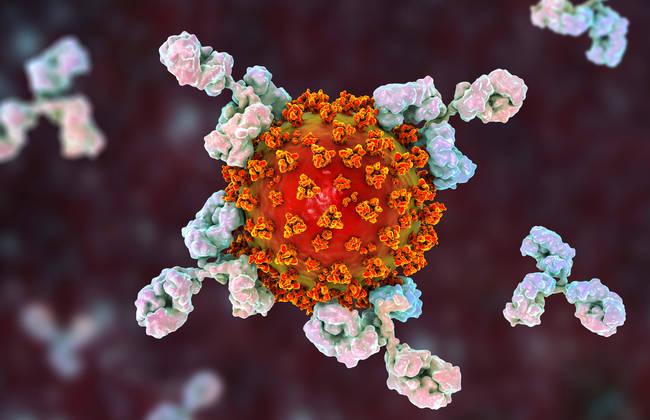COVID-19: How is Severity of the Disease Related to Antibody Response?
Researchers from the Paul-Ehrlich-Institut jointly with teams of the University Hospital at Frankfurt/Main and the Leibniz Institute for Primate Research (Leibniz-Instituts für Primatenforschung) at Göttingen have studied the antibody response of COVID-19 patients in Germany. The aim was to gain new insights into the course of the disease and immune reactions, and to identify possible protection correlates required for the development of vaccines and therapeutic antibodies. The Journal of Infectious Diseases reports on the results of the study in its online version of 31 October 2020.

More than 47 million people have so far became infected with coronavirus SARS-CoV-2 worldwide, and around 1.2 million deaths are related to a SARS-CoV-2 infection. Courses of infection with SARS-CoV-2 differ greatly between infected persons. While part of those infected do not develop many signs of disease at all, others have a serious outcome in which different organs can be affected. In around two percent of the cases confirmed in Germany, the disease is lethal. Developing effective therapeutic approaches requires extensive insights into the pathogenesis of SARS-CoV-2 and the immunological processes involved. These insights are also needed to understand why the disease differs greatly between individuals. Besides the processes of innate immune response, mainly the two parts of the acquired immunity are key to the immune response against the coronavirus SARS-CoV-2: On the one hand, there is the formation of specific antibodies (immunoglobulins), which can neutralise and inactivate the virus. This immune response is called humoral immune response. The other pillar refers to the formation of specific immune cells (T-cells), the cellular immune response, these cells can kill infected cells.
Professor Barbara Schnierle, head of Section "AIDS, New and Novel Pathogens", and her teams, and Dr Heinrich Scheiblauer, deputy head of the Testing Laboratory for In-vitro Diagnostic Medical Devices jointly with researchers of the University Hospital at Frankfurt/Main and the Leibniz-Institute for Primate Research at Göttingen, characterised the humoral immune response – the antibody formation – in a cohort of 143 COVID-19 patients at the University Hospital at Frankfurt/Main. They identified SARS-CoV-2-specific antibodies by means of enzyme-linked immunosorbent assay (ELISA). The neutralisation activity, i.e. the ability of the antibody to block the attachment of the SARS-CoV-2 virus to the cellular ACE2 receptors and thus inhibit the infection of cells was analysed using so-called pseudotyped lentiviral vectors. These are replication incompetent virus particles equipped with the spike protein of the SARS-CoV-2 virus, which can bind to ACE2 receptors.
Around three quarters of the 143 COVID-19 patients had only mild signs of disease. In older patients, however, especially male patients, serious cases were more common. The clinical degree of severity showed a positive correlation with the titre of SARS-CoV-2 neutralising antibodies in the serum samples of the patients. Besides, titres of particular antibodies, immunoglobulins (Ig) IgG and IgA targeted against the SARS-CoV-2 spike protein or the receptor binding domain (RBD) in the spike protein correlated with the severity of the disease. In patients with mild clinical symptoms, a decrease in IgG antibody titres was detected in blood samples collected at later time points.
Altogether, the neutralising antibody titres of patients with a mild course of disease were very low. Higher titres were only detected in persons with a serious outcome. This confirms previously reported observations, which showed that most convalescent plasma samples from persons who had recovered from COVID-19, do not reveal high neutralising antibody activity. The possibility of cross-reactivity has frequently been discussed: This means that previous exposure to related harmless human coronaviruses may equip the immune system with better protection from a SARS-CoV-2 infection.
The human coronavirus NL63 (HCoV-NL63) was first described in 2004. It causes minor to medium severe infections of the airways. Serological data on NL63 infections are available mainly from children and point to a possible high frequency of HCoV-NL63 infection during childhood. This gives rise to speculations that existing immunity against HCoV-NL63 or other common cold coronaviruses may lower the risk of a serious course of disease. The study referenced here showed some evidence of a correlation between a serious course of COVID-19 disease and a low HCoV-NL63-neutralising activity, however, only a small number of samples concerning this was available, but the evidence gained here will certainly justify conducting further studies.
Original Publication
Henss L, Scholz T, von Rhein C, Wieters I, Borgans F, Eberhardt FJ, Zacharowski K, Ciesek S, Rohde G, Vehreschild M, Stephan C, Wolf T, Hofmann-Winkler H, Scheiblauer H, Schnierle BS (2020): Analysis of humoral immune responses in SARS-CoV-2 infected patients.
J Infect Dis 223: 56-61.
Online-Abstract
top



